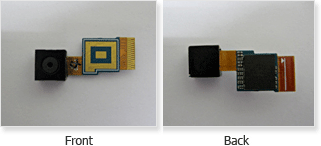Samsung Galaxy S 2 (International) Review - The Best, Redefined
by Brian Klug & Anand Lal Shimpi on September 11, 2011 11:06 AM EST- Posted in
- Smartphones
- Samsung
- Galaxy S II
- Exynos
- Mobile
Behind SGS2's Camera - Still Quality
Now the next subject is still image capture on SGS2. Before I go any further, I think now is as good at time as any to talk about what sensors are in the device. Getting to the bottom of this took some poking around, and where I started was the camera firmware. Usually getting what sensors are used in a given device is pretty straightforward - look for driver messages in dmesg when the kernel boots, and then see which ones correspond to cameras. However, on SGS2 the thing is hidden behind a custom ISP that talks over I2C to Exynos, which didn’t lead me much further than just finding out what particular ISP is onboard.
I opened the camera firmware (from /system/etc/firmware ) in a hex editor and fired away. There are number of interesting things which pop up. First up is this:
Softune REALOS/FR is Realtime OS for FR Family, based on micro-ITRON COPYRIGHT(C) FUJITSU LIMITED 1994-1999
So we know that the ISP is Fujitsu. Then there’s a line like this:
Copyright (c) 2005-2008 by FotoNation. All rights reserved. Face Detection Library v.1.2.58.7
and finally:
OBED04 Fujitsu M5MOLS
all strewn among a bunch of padded bits and compiled code incorporated into the SGS2’s “camera” firmware. So what’s the real story? Well, SGS2 uses a Fujitsu Milbeaut M–5MO ISP paired with one of two cameras. To find out which camera SGS2 uses, I took a look in Francois’ SGS2 kernel repo under the actual M5MO C driver file. Inside, there’s a line like this inside a function named “m5mo_camera_type_show”:
if (state->exif.unique_id[1] == 'B') { strcpy(type, "SONY_IMX105PQ_M5MOLS"); } else if (state->exif.unique_id[1] == 'C') { strcpy(type, "SLSI_S5K3H2YX_M5MOLS"); } else { cam_warn("cannot find the matched camera type\n"); strcpy(type, "SONY_IMX105PQ_M5MOLS"); }
So we now know that inside SGS2 is either a Sony IMX105, or Samsung S5K3H2YX sensor. This is basically the same exact camera lottery situation that the MyTouch 4G Slide is in, as it in fact has the same two exact sensors listed, though F/2.2 optics. Both are basically the same on paper and should offer similar performance - 1/3.2“ size, 1.4µm backside illuminated pixels, and 8.13 MP (3264 x 2448). The front-facing camera uses a Samsung S5K5BAF 2 MP sensor sized 1/5” and with 1.75µm square pixels.

Interestingly enough, I believe I was able to find the actual module which Samsung uses inside the SGS2 on a Samsung fiber optics website, using the Sony IMX105 module. Take note of the appearance of this module, as it’s virtually identical to what I saw inside the device as I’ll show in a moment.
Having two sensor suppliers isn’t anything new, Apple has done it (and will continue to do so), HTC is doing it, and now Samsung is doing it too. With the same on-paper sensor performance and the same autofocus + optical system module, things should all work out and photos should look the same no matter what sensor is inside.
Other specs about the camera module are that EXIF reports an F/2.7 aperture and 4.0 mm focal length. This is a bit odd to me since F/2.8 is on the typical full-stop scale (2*sqrt(2)), and then F/2.4 is a next half-stop, and I’m only aware of IMX105 coming in F/2.4 and 2.8 modules. Just goes to show that sometimes EXIF data is weird. The module is most definitely the F/2.8, f=4.15 mm variant with a 28.1 degree horizontal field of view and 4 plastic aspheric lenses.
As an aside, if this whole system sounds familiar, it’s because the Sony IMX105 module with F/2.4 optics is the oft-rumored camera going into the next iPhone.
So that brings me to the infamous magenta circle issue which numerous people have reported seeing on their SGS2s. The last time we saw this was with the iPhone 4, where a green circle is readily apparent under certain light conditions or when photographing a homogenous color or texture. Some users have reported seeing a similar magenta circle on the SGS2 camera when photographing under similar conditions, so I set out to replicate it.
 The closest I can get to the magenta circle
The closest I can get to the magenta circle
For better or worse, I can’t see the magenta circle on the SGS2 we were given, though I don’t doubt that some devices do show it. It doesn’t take much to extrapolate and come to the conclusion that is in part due to what’s becoming a CMOS lottery - now not only is there a display lottery (like what notebook buyers have been dealing with for a long time), but a CMOS lottery for sensors.
The magenta circle I see on this SGS2 is faint and nowhere near as pronounced as the green iPhone 4 circle, nor the SGS2-captured images I’ve seen online. Further, I haven’t been able to devise a method to tell which of the two possible sensors are inside this particular SGS2. I’ve taken some photos of completely white objects at a variety of focus positions and under different lighting conditions for your own perusal.
We’ve done the usual thing too and taken photos with the SGS2 inside our lightbox test scene, with the lights on and lights off. With the lights on, the SGS2 has a hard time nailing white balance with the test illuminated in auto mode, and in manual mode (set appropriately) it still has the wrong color temperature. This is just a bit unfortunate since otherwise sharpness is excellent, there’s little noise, and little to no chromatic fringing at the edges. I’m very impressed with camera performance here and would encourage viewing those images 1:1.
On the front facing camera, we get performance that looks actually surprisingly good. So good that it could actually pass for rear facing camera quality (resolution notwithstanding) of some previous generation devices.
With the lights out, the SGS2’s single LED flash illuminates the test scene nicely and gives good color temperature. SGS2 also does the right thing and fires up the LED for autofocus in the dark.
Next, we took photos with the SGS2 at the usual test locations, and it’s here that SGS2’s camera really shines. As a reminder, test locations 3, 4, 6, and 7 are the only ones remaining that I can visit, so skip 1, 2, and 5. SGS2 just really has great well-corrected sharpness and performance even out at the edges where aberrations take off, good colors without insane saturation, and great dynamic range.
Finally, I captured a large number of miscellaneous photos with the SGS2’s rear facing camera as well. I think in these real-world scenarios we get to see a better example of the SGS2’s camera performance, which is extremely good among the smartphones we’ve seen so far. Samsung also doesn’t make the mistake of putting the last vertex of the camera system behind a piece of plastic integrated into the battery cover. Instead, the module juts out through the battery cover in a way that doesn’t allow dirt and dust to collect.









































132 Comments
View All Comments
Astri - Sunday, September 11, 2011 - link
Great work, the difference is obvious! Cant wait for the releasethanks for your reply. is good to know that is not hardware issue. it gives us hopes for quality gradients in future sw updates
supercurio - Sunday, September 11, 2011 - link
I'm glad it works for you ;)Don't expect Samsung to change the screen rendering in an update because if some would prefer "Native", others would not after loosing some perceived sharpness even if it's an artificial one that creates halos and artifacts.
Anyway the app is here, and free!
Jon Irenicus - Monday, September 12, 2011 - link
Your audio section scared me about the audio quality, is there any chance the US sprint variant will use a different DAC? or get a tweaked version of the Yamaha DAC?supercurio - Monday, September 12, 2011 - link
From dumps I received AT&T and Sprint versions are exactly the same for audio.T-Mobile, I'm not sure yet, I got some dumps from an non released device with a separate Yamaha headphone+speaker driver that looked like a potential T-Mobile Galaxy S II.
No idea about the DAC itself today.
Gnarr - Sunday, September 11, 2011 - link
"TouchWiz 4.0 is a much cleaner, less claustrophobic, and considerably less garish experience."http://en.wikipedia.org/wiki/Claustrophobia
DeciusStrabo - Monday, September 12, 2011 - link
"something feels claustrophobic" isn't an uncommon phrase for saying something feels small, cluttered and cramped.jigglywiggly - Sunday, September 11, 2011 - link
THIS IS THE MOST INDEPTH REVIEW FOR A PHONE EVAROmid.M - Monday, September 12, 2011 - link
And their childishness?Look what they've done to the American versions of the SGS2. Childish, for wanting their own "version" of an amazing phone. Why mess with a great thing? Oh, because you don't want to just compete on service--as you should--you want "exclusive" features on your version of the phone?
Wish I was on AT&T so I could import the Int'l version.
Brian,
I'm honestly amazed at your 180. I recall you being a little "so what?" about the SGS2 (this is way back before summer 2011) and now it looks to be your favorite smartphone (I think). And we know you're a harsh critic :)
I hope we get to see soon what the SGS3 might look like: will Samsung keep with the Exynos SoC and add LTE to compete with Krait? What will the next gen Mali GPU look like? Next Gen SAMOLED? So curious...and yet, we know an SGS3 wouldn't reach America for at least another 18 months...hopefully, VZW customers won't be let down by a Nexus Prime (and that includes bloat).
The addition of Supercurio (Francois) is perfect; you have a talented dev who is passionate enough to explain to the layman how things work. He's helped me on more than one occasion when I had a Fascinate :)
Great work, Anand, Brian, and Francois. One of the best reviews I've ever read on any product. No question.
@moids
ph00ny - Monday, September 12, 2011 - link
Agreed. My main reason for purchasing the international version this time around was to receive more timely updates along with less restrictions.As for next gen, there is already a LTE version of SGS2 and ARM already announced the next gen Mali graphics quite some time ago. Regardless, no one knows if samsung will use mali's gpu on the SGS3 and hopefully the SGS3 will come in an ATT compatible flavor when it's released
Brian Klug - Monday, September 12, 2011 - link
I definitely admit that I was very *meh* about the phone after seeing it at MWC. It clearly has come a really, really long way, and now it's my absolute favorite Android device because of all those reasons outlined above - just incredible smoothness and huge performance. :)-Brian